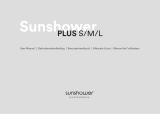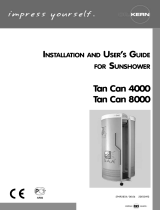
UV and your health
Just as with natural sunlight, the tanning process will take some time. The rst effect will only become
visible after a few sessions (see section ‘Tanning sessions: how often and how long?’).
Overexposure to ultraviolet light (natural sunlight or articial light from your tanning appliance) can
cause sunburn. Besides many other factors, such as overexposure to natural sunlight, incorrect and
excessive use of a tanning appliance may increase the risk of skin and eye problems. The degree to
which these effects occur is determined by the nature, intensity and duration of the exposure on
the one hand and the sensitivity of the person involved on the other hand.The more the skin and
the eyes are exposed to UV light, the higher the risk of keratitis, conjunctivitis, damage to the retina,
cataracts, premature skin ageing and the development of skin tumours will be. Some medications
and cosmetics increase the sensitivity of the skin.
It is therefore highly important:
that you follow the instructions in chapter ‘Important’ and section ‘Tanning sessions: how often
and how long?’;
that the tanning distance (the distance between the appliance and your face) is 10 cm;
that you do not exceed the maximum number of tanning hours per year (i.e. 24 hours or
1440 minutes);
that you always wear the goggles provided while tanning.
Tanning sessions: how often and how long?
Do not take more than one tanning session per day, over a period of ve to ten days
Allow an interval of at least 48 hours between the rst and the second session.
After this 5- to 10-day course, we advise you to give your skin a rest for a while.
Approximately one month after a course, your skin will have lost much of its tan. You can
then start a new course.
If you want to keep your tan, do not stop tanning after the course, but continue taking one
or two tanning sessions a week.
Whether you choose to stop tanning for a while or whether you continue tanning on a
lower frequency, always keep in mind that you must not exceed the maximum number of
tanning hours.
For this appliance the maximum is 24 tanning hours (=1440 minutes) a year.
Example
Suppose you are taking a 10-day tanning course, consisting of a 9-minute session on the rst day
and a 25-minute session on each of the following nine days.
The entire course will then last (1 x 9 minutes) + (9 x 25 minutes) = 234 minutes.
In one year you can take 6 of these courses, as 6 x 234 minutes = 1404 minutes.
Table
As is shown in the table, the first session of a tanning course should always last 9 minutes,
irrespective of the sensitivity of the skin. If you think that the sessions are too long for you (e.g. if the
skin gets taut and tender after the session), we advise you to reduce the length of the sessions by
e.g. 5 minutes.
Note:For a beautiful, even tan, turn your face to the left and right from time to time during the session so
that the sides of the face are better exposed to the tanning light.
Note:If your skin feels slightly taut after tanning, you can apply a moisturising cream.
Duration of the
tanning session in
minutes
for persons with very
sensitive skin
for persons with
normal sensitive skin
for persons with less
sensitive skin
1st session 9 9 9
break of at least
48 hours
break of at least
48 hours
break of at least
48 hours
break of at least
48 hours
,
-
-
-
-
,
,
,
,
,
,
,
ENGLISH 7







